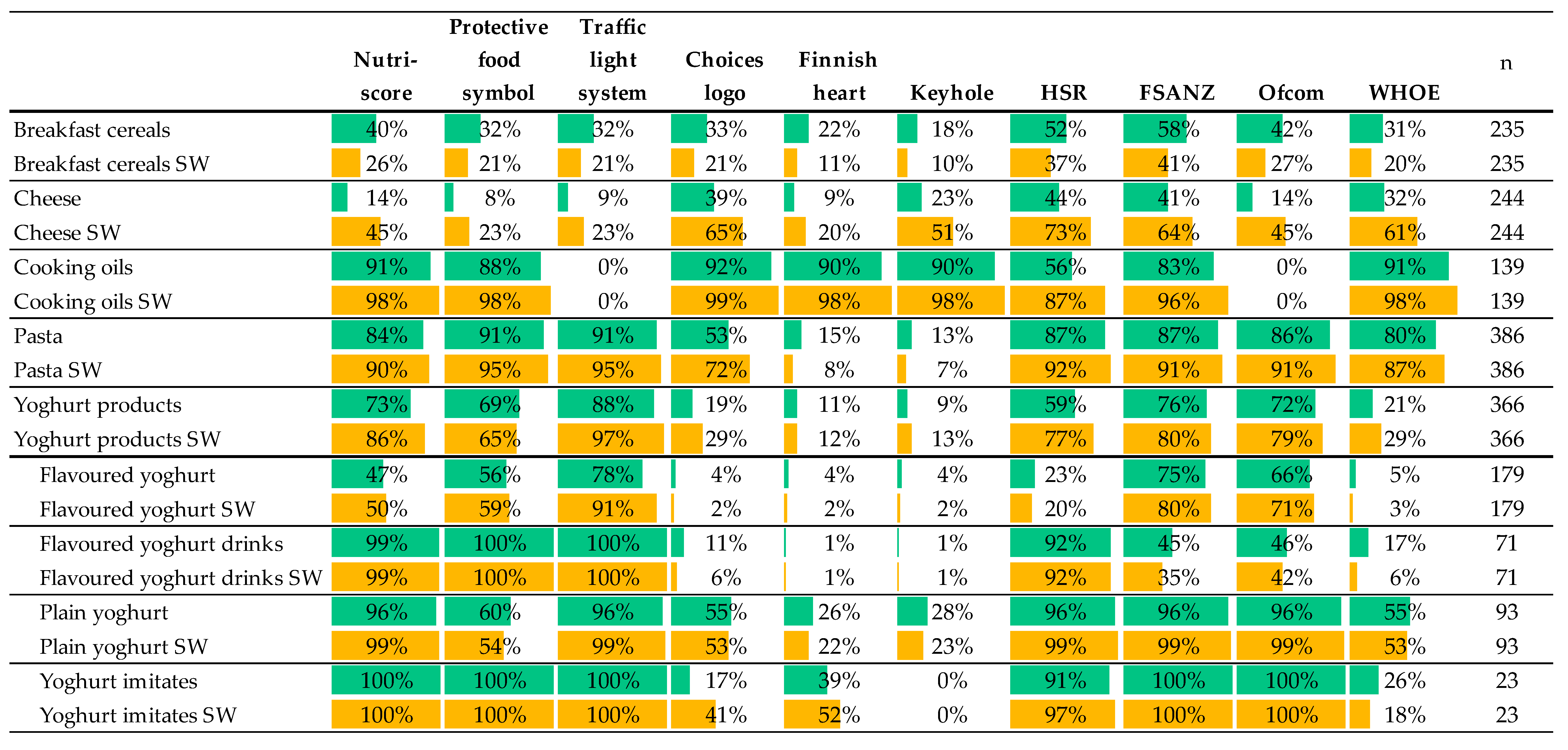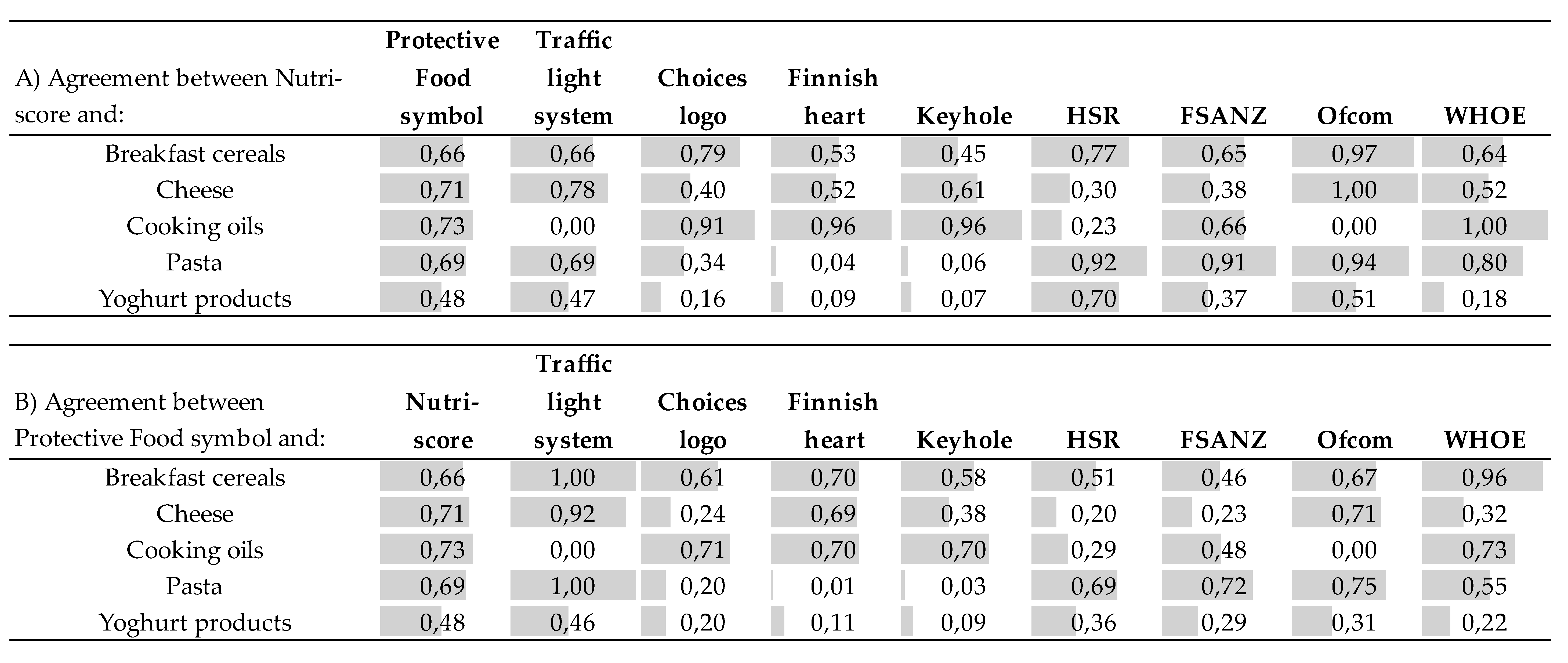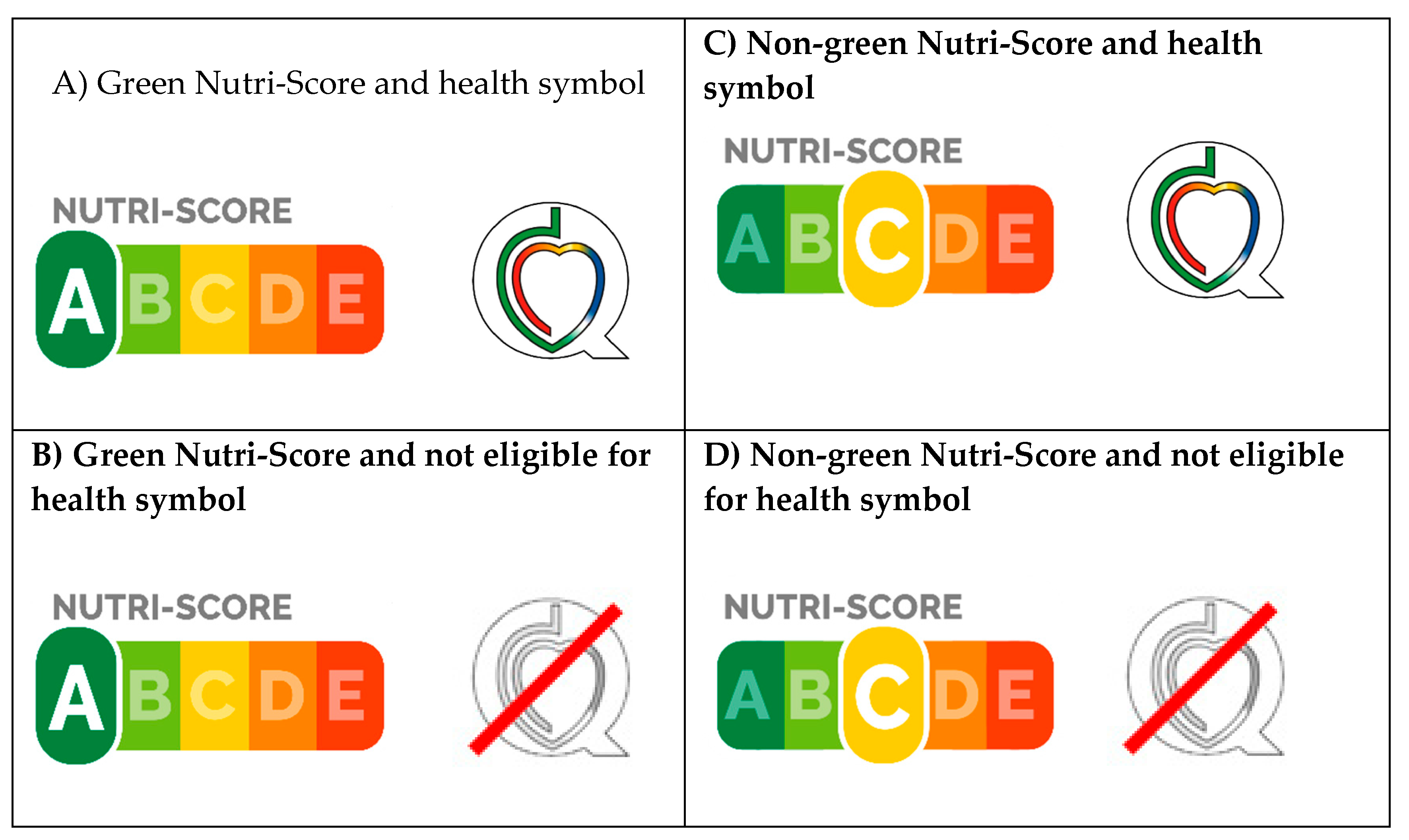Facilitating Consumers Choice of Healthier Foods: A Comparison of Different Front-of-Package Labelling Schemes Using Slovenian Food Supply Database
Abstract
1. Introduction
2. Materials and Methods
2.1. Food Database, Product Categorization and Nutritional Composition
2.2. Used Nutrient Profiling Models
2.3. Data Processing and Statistical Analyses
3. Results
3.1. Proportion of “Healthier Products” by Tested Nutrient Profiling Models
3.2. Sales Weighted Proportion of “Healthier Products” by Tested Nutrient Profiling Models
3.3. The Agreement Between the Tested Nutrient Profiling Models
3.4. Situation Scenarios of Food Labelling with the Use of a Health Symbol and Accompanying Interpretive Nutrition Rating System
4. Discussion
5. Conclusions
Author Contributions
Funding
Acknowledgments
Conflicts of Interest
References
- Dunford, E.K.; Ni Mhurchu, C.; Huang, L.; Vandevijvere, S.; Swinburn, B.; Pravst, I.; Tolentino-Mayo, L.; Reyes, M.; L’Abbé, M.; Neal, B.C. A comparison of the healthiness of packaged foods and beverages from 12 countries using the Health Star Rating nutrient profiling system, 2013–2018. Obes. Rev. 2019, 20, 107–115. [Google Scholar] [CrossRef] [PubMed]
- Raikos, V.; Ranawana, V. Reformulation as a Strategy for Developing Healthier Food Products: Challenges, Recent Developments and Future Prospects. Springer Nature Switzerland AG, 2019. Available online: https://www.springer.com/de/book/9783030236205 (accessed on 13 January 2020).
- Vandevijvere, S.; Vanderlee, L. Effect of formulation, labelling, and taxation policies on the nutritional quality of the food supply. Curr. Nutr. Rep. 2019, 8, 240–249. [Google Scholar] [CrossRef] [PubMed]
- Julia, C.; Hercberg, S. Research and lobbying conflicting on the issue of a front-of-pack nutrition labelling in France. Arch. Public Health 2016, 74, 51. [Google Scholar] [CrossRef] [PubMed]
- van Gunst, A.; Roodenburg, A.J.C. Consumer Distrust about E-numbers: A Qualitative Study among Food Experts. Foods 2019, 8, 178. [Google Scholar] [CrossRef]
- Timmerman, N.; Piqueras-Fiszman, B. The Effect of Ingredient Item Depiction on the Packaging Frontal View on Pre- and Post-Consumption Product Evaluations. Foods 2019, 8, 354. [Google Scholar] [CrossRef]
- Wlodarska, K.; Pawlak-Lemanska, K.; Gorecki, T.; Sikorska, E. Factors Influencing Consumers’ Perceptions of Food: A Study of Apple Juice Using Sensory and Visual Attention Methods. Foods 2019, 8, 545. [Google Scholar] [CrossRef]
- Kanter, R.; Vanderlee, L.; Vandevijvere, S. Front-of-package nutrition labelling policy: Global progress and future directions. Public Health Nutr. 2018, 21, 1399–1408. [Google Scholar] [CrossRef]
- Van Der Bend, D.; Van Dieren, J.; De Vasconcelos Marques, M.; Wezenbeek, N.L.W.; Kostareli, N.; Guerreiro Rodrigues, P.; Temme, E.H.M.; Westenbrink, S.; Verhagen, H. A Simple Visual Model to Compare Existing Front-of-pack Nutrient Profiling Schemes. Eur. J. Nutr. Food Saf. 2014, 4, 429–534. [Google Scholar] [CrossRef]
- Hodgkins, C.; Barnett, J.; Wasowicz-Kirylo, G.; Stysko-Kunkowska, M.; Gulcan, Y.; Kustepeli, Y.; Akgungor, S.; Chryssochoidis, G.; Fernandez-Celemin, L.; Storcksdieck genannt Bonsmann, S.; et al. Understanding how consumers categorise nutritional labels: A consumer derived typology for front-of-pack nutrition labelling. Appetite 2012, 59, 806–817. [Google Scholar] [CrossRef]
- Pauwels, K.; Erguncu, S.; Yildirim, G. Winning hearts, minds and sales: How marketing communication enters the purchase process in emerging and mature markets. Int. J. Res. Mark. 2013, 30, 57–68. [Google Scholar] [CrossRef]
- Dunford, E.K.; Huang, L.; Peters, S.A.E.; Crino, M.; Neal, B.C.; Ni Mhurchu, C. Evaluation of Alignment between the Health Claims Nutrient Profiling Scoring Criterion (NPSC) and the Health Star Rating (HSR) Nutrient Profiling Models. Nutrients 2018, 10, 1065. [Google Scholar] [CrossRef] [PubMed]
- Poon, T.; Labonte, M.E.; Mulligan, C.; Ahmed, M.; Dickinson, K.M.; L’Abbe, M.R. Comparison of nutrient profiling models for assessing the nutritional quality of foods: A validation study. Br J Nutr 2018, 120, 567–582. [Google Scholar] [CrossRef] [PubMed]
- Rayner, M. Nutrient profiling for regulatory purposes. Proc. Nutr. Soc. 2017, 76, 230–236. [Google Scholar] [CrossRef]
- FSANZ. Australia New Zealand Food Standards Code: Schedule 5—Nutrient profiling scoring method. In Food Standards Gazette, F2017C00318; Australian Government: Canberra, Australia, 2017. [Google Scholar]
- von Wagner, C.; Knight, K.; Steptoe, A.; Wardle, J. Functional health literacy and health-promoting behaviour in a national sample of British adults. J. Epidemiol. Community Health 2007, 61, 1086–1090. [Google Scholar] [CrossRef]
- Przyrembel, H. Food labelling legislation in the EU and consumers information. Trends Food Sci. Technol. 2004, 15, 360–365. [Google Scholar] [CrossRef]
- Gabrijelčič Blenkuš, M.; Gregorič, M.; Tivadar, B.; Koch , V.; Kostanjevec, S.; Fajdiga Turk, V.; Žalar, A.; Lavtar, D.; Kuhar, D.; Rozman, U. Prehrambene Navade Odraslih Prebivalcev Slovenije z Vidika Varovanja Zdravja; Univerza v Ljubljani, Pedagoška Fakulteta: Ljubljana, Slovenia, 2009; p. 183. [Google Scholar]
- Ares, G.; Varela, F.; Machin, L.; Antúnez, L.; Giménez, A.; Curutchet, M.R.; Aschemann-Witzel, J. Comparative performance of three interpretative front-of-pack nutrition labelling schemes: Insights for policy making. Food Qual. Prefer. 2018, 68, 215–225. [Google Scholar] [CrossRef]
- Egnell, M.; Talati, Z.; Hercberg, S.; Pettigrew, S.; Julia, C. Objective Understanding of Front-of-Package Nutrition Labels: An International Comparative Experimental Study across 12 Countries. Nutrients 2018, 10, 1542. [Google Scholar] [CrossRef]
- Društvo za Zdravje srca in Ožilja Slovenije. Pravilnik o Pogojih Podeljevanja Pravice do Uporabe Kolektivne Blagovne Znamke Varuje Zdravje. Available online: http://zasrce.si/wp-content/uploads/2011/12/Pravilnik_varovalna-%C5%BEivila.pdf (accessed on 13 January 2020).
- Miklavec, K.; Pravst, I.; Raats, M.M.; Pohar, J. Front of package symbols as a tool to promote healthier food choices in Slovenia: Accompanying explanatory claim can considerably influence the consumer’s preferences. Food Res. Int. 2016, 90, 235–243. [Google Scholar] [CrossRef]
- Hieke, S.; Kuljanic, N.; Pravst, I.; Miklavec, K.; Kaur, A.; Brown, K.A.; Egan, B.M.; Pfeifer, K.; Gracia, A.; Rayner, M. Prevalence of nutrition and health-related claims on pre-packaged foods: A five-country study in Europe. Nutrients 2016, 8, 137. [Google Scholar] [CrossRef]
- Larsson, I.; Lissner, L.; Wilhelmsen, L. The ‘Green Keyhole’ revisited: Nutritional knowledge may influence food selection. Eur. J. Clin. Nutr. 1999, 53, 776–780. [Google Scholar] [CrossRef] [PubMed]
- Lahti-Koski, M.; Helakorpi, S.; Olli, M.; Vartiainen, E.; Puska, P. Awareness and use of the Heart Symbol by Finnish consumers. Public Health Nutr. 2012, 15, 476–482. [Google Scholar] [CrossRef]
- Vyth, E.L.; Steenhuis, I.H.M.; Vlot, J.A.; Wulp, A.; Hogenes, M.G.; Looije, D.H.; Brug, J.; Seidell, J.C. Actual use of a front-of-pack nutrition logo in the supermarket: Consumers motives in food choice. Public Health Nutr. 2010, 13, 1882–1889. [Google Scholar] [CrossRef] [PubMed]
- Julia, C.; Etile, F.; Hercberg, S. Front-of-pack Nutri-Score labelling in France: An evidence-based policy. Lancet Public Health 2018, 3, e164. [Google Scholar] [CrossRef]
- Julia, C.; Hercberg, S. Development of a new front-of-pack nutrition label in France: The five-colour Nutri-Score. Public Health Panor. 2017, 3, 712–725. [Google Scholar]
- WHO. France Becomes one of the First Countries in Region to Recommend Colour-Coded Frontof-Pack Nutrition Labelling System. Available online: http://www.euro.who.int/en/countries/france/news/news/2017/03/france-becomes-one-of-the-first-countries-in-region-to-recommend-colour-coded-front-of-pack-nutrition-labelling-system (accessed on 13 January 2020).
- FoodDrinkEurope. Statement on French “NutriScore” Proposal. Available online: https://www.fooddrinkeurope.eu/news/statement/statement-on-french-nutriscore-proposal/ (accessed on 13 January 2020).
- Pivk Kupirovič, U.; Miklavec, K.; Hribar, M.; Kušar, A.; Žmitek, K.; Pravst, I. Nutrient Profiling Is Needed to Improve the Nutritional Quality of the Foods Labelled with Health-Related Claims. Nutrients 2019, 11, 287. [Google Scholar] [CrossRef] [PubMed]
- The National Food Agency. The Keyhole Symbol. Available online: https://www.livsmedelsverket.se/globalassets/om-oss/lagstiftning/livsmedelsinfo-till-konsum---markning/livsfs-2015-1-particular-symbol-eng.pdf (accessed on 13 January 2020).
- Choices Programme. Dutch Product Criteria. Description of the Criteria for a Food Choice Logo. Available online: https://www.choicesprogramme.org/uploads/PDF/dutch-choices-criteria-2015-v2.pdf (accessed on 13 January 2020).
- Sydänmerkki. Heart Symbol, A Better Choice. Available online: http://www.sydanmerkki.fi/en (accessed on 13 January 2020).
- Commonwealth of Australia. Applying Health Star Ratings: Guide for Industry. Available online: http://www.healthstarrating.gov.au/internet/healthstarrating/publishing.nsf/Content/guide-for-industry-document (accessed on 13 January 2020).
- Slovene Consumers’ Association. Traffic Light System for Food. Available online: https://veskajjes.si/ (accessed on 13 January 2020).
- NUTRIS. Innovative Solutions for Informed Choices. Available online: https://www.nutris.org/en/innovative-solutions-for-informed-choices (accessed on 23 March 2020).
- Rayner, M.; Scarborough, P.; Lobstein, T. The UK Ofcom Nutrient Profiling Model. Available online: https://assets.publishing.service.gov.uk/government/uploads/system/uploads/attachment_data/file/216094/dh_123492.pdf (accessed on 13 January 2020).
- WHO. WHO Regional Office for Europe Nutrient Profile Model. Available online: http://www.euro.who.int/__data/assets/pdf_file/0005/270716/Nutrient-children_web-new.pdf (accessed on 13 January 2020).
- FSA. UK. Food Using Traffic Lights. Available online: https://www.resourcesorg.co.uk/assets/pdfs/foodtrafficlight1107.pdf (accessed on 8 January 2020).
- McHugh, M.L. Interrater reliability: The kappa statistic. Biochem. Med. 2012, 22, 276–282. [Google Scholar] [CrossRef]
- Eržen, N.; Rayner, M.; Pravst, I. A comparative evaluation of the use of a food composition database and nutrition declarations for nutrient profiling. J. Food Nutr. Res. 2015, 54, 93–100. [Google Scholar]
- Shankar, P.; Ahuja, S.; Sriram, K. Non-nutritive sweeteners: Review and update. Nutrition 2013, 29, 1293–1299. [Google Scholar] [CrossRef]
- WHO. The World Health Report: Reducing Risks, Promoting Healthy Life; World Health Organization: Geneva, Switzerland, 2002; p. 248. [Google Scholar]
- Hutchings, S.C.; Low, J.Y.Q.; Keast, R.S.J. Sugar reduction without compromising sensory perception. An impossible dream? Crit. Rev. Food Sci. Nutr. 2019, 59, 2287–2307. [Google Scholar] [CrossRef]
- Nicklaus, S.; Schwartz, C. Early influencing factors on the development of sensory and food preferences. Curr. Opin. Clin. Nutr. Metab. Care 2019, 22, 230–235. [Google Scholar] [CrossRef] [PubMed]
- Roodenburg, A.J.C. Nutrient profiling for front of pack labelling: How to align logical consumer choice with improvement of products? Proc. Nutr. Soc. 2017, 76, 247–254. [Google Scholar] [CrossRef] [PubMed][Green Version]
- Labonte, M.E.; Poon, T.; Mulligan, C.; Bernstein, J.T.; Franco-Arellano, B.; L’Abbe, M.R. Comparison of global nutrient profiling systems for restricting the commercial marketing of foods and beverages of low nutritional quality to children in Canada. Am. J. Clin. Nutr. 2017, 106, 1471–1481. [Google Scholar] [CrossRef] [PubMed]



| Nutri-Score | Protective Food Symbol | Traffic Light System | Choices Symbol | Finnish Heart | Keyhole | HSR | FSANZ | Ofcom | WHOE | |
|---|---|---|---|---|---|---|---|---|---|---|
| Origin | FR | SI | UK | NL | FI | SE | AU, NZ | AU, NZ | UK | EU MS for adaptation |
| Year of issue | 2017 | 1992 | 2008 | 2007 | 2000 | 1989 | 2016 | 2016 | 2007 | 2015 |
| Use in other countries | ES, BE | / | SI | NL, BE, CZ, NG | / | DK, NO, IS | / | / | / | / |
| Purpose | Food labelling: Rating system | Food labelling: Health symbol | Food labelling: Rating system | Food labelling: Health symbol | Food labelling: Health symbol | Food labelling: Health symbol | Food labelling: Rating system | Limit use of NH claims | Limit food marketing to children | Limit food marketing to children |
| Considered as healthier where: | Scores A and B | Allowed to carry symbol | No red light | Allowed to carry symbol | Allowed to carry symbol | Allowed to carry symbol | Greater than 3.5 | Allowed to carry NH claim | Allowed for marketing to kids | Allowed for marketing to kids |
| Visual | Colour and letter-coded (from green to red, A-E) | Symbol | Colour coded (green, amber, red) | Symbol | Symbol | Symbol | Numerical code (0,5-5 stars) | NA | NA | NA |
| No. of food categories | 4 | 6 | 2 | 31 | 59 | 33 | 6 | 3 | 2 | 20 |
| Modeling method | Score N-P points | Value within limits + NH | Value within limits | Value within limits | Value within limits | Value within limits | Score N-P points | Score N-P points | Score N-P points | Value within limits |
| Nutrients included in the modeling method | ||||||||||
| Energy | Yes | Yes | Yes | Yes | For pasta only | |||||
| Total fat | Yes | Yes | Yes | Yes | Yes | |||||
| Sat. fat | Yes | Yes | Yes | Yes | Yes | Yes | Yes | Yes | Yes | Yes |
| Total sugar | Yes | Yes | Yes | Yes | Yes | Yes | Yes | Yes | Yes | Yes |
| Salt | Yes | Yes | Yes | Yes | Yes | Yes | Yes | Yes | Yes | Yes |
| FVN | Yes | Yes | Yes | Yes | ||||||
| Proteins | Yes | For some | Yes | Yes | Yes | |||||
| Fiber | Yes | For some | Yes | Yes | Yes | Yes | Yes | Yes | ||
| Trans fat | For some | For some | For some | For some | ||||||
| Sweetener | Yes | For some | ||||||||
| Added sugar | For some | For some | For some | For some | ||||||
© 2020 by the authors. Licensee MDPI, Basel, Switzerland. This article is an open access article distributed under the terms and conditions of the Creative Commons Attribution (CC BY) license (http://creativecommons.org/licenses/by/4.0/).
Share and Cite
Pivk Kupirovič, U.; Hristov, H.; Hribar, M.; Lavriša, Ž.; Pravst, I. Facilitating Consumers Choice of Healthier Foods: A Comparison of Different Front-of-Package Labelling Schemes Using Slovenian Food Supply Database. Foods 2020, 9, 399. https://doi.org/10.3390/foods9040399
Pivk Kupirovič U, Hristov H, Hribar M, Lavriša Ž, Pravst I. Facilitating Consumers Choice of Healthier Foods: A Comparison of Different Front-of-Package Labelling Schemes Using Slovenian Food Supply Database. Foods. 2020; 9(4):399. https://doi.org/10.3390/foods9040399
Chicago/Turabian StylePivk Kupirovič, Urška, Hristo Hristov, Maša Hribar, Živa Lavriša, and Igor Pravst. 2020. "Facilitating Consumers Choice of Healthier Foods: A Comparison of Different Front-of-Package Labelling Schemes Using Slovenian Food Supply Database" Foods 9, no. 4: 399. https://doi.org/10.3390/foods9040399
APA StylePivk Kupirovič, U., Hristov, H., Hribar, M., Lavriša, Ž., & Pravst, I. (2020). Facilitating Consumers Choice of Healthier Foods: A Comparison of Different Front-of-Package Labelling Schemes Using Slovenian Food Supply Database. Foods, 9(4), 399. https://doi.org/10.3390/foods9040399







